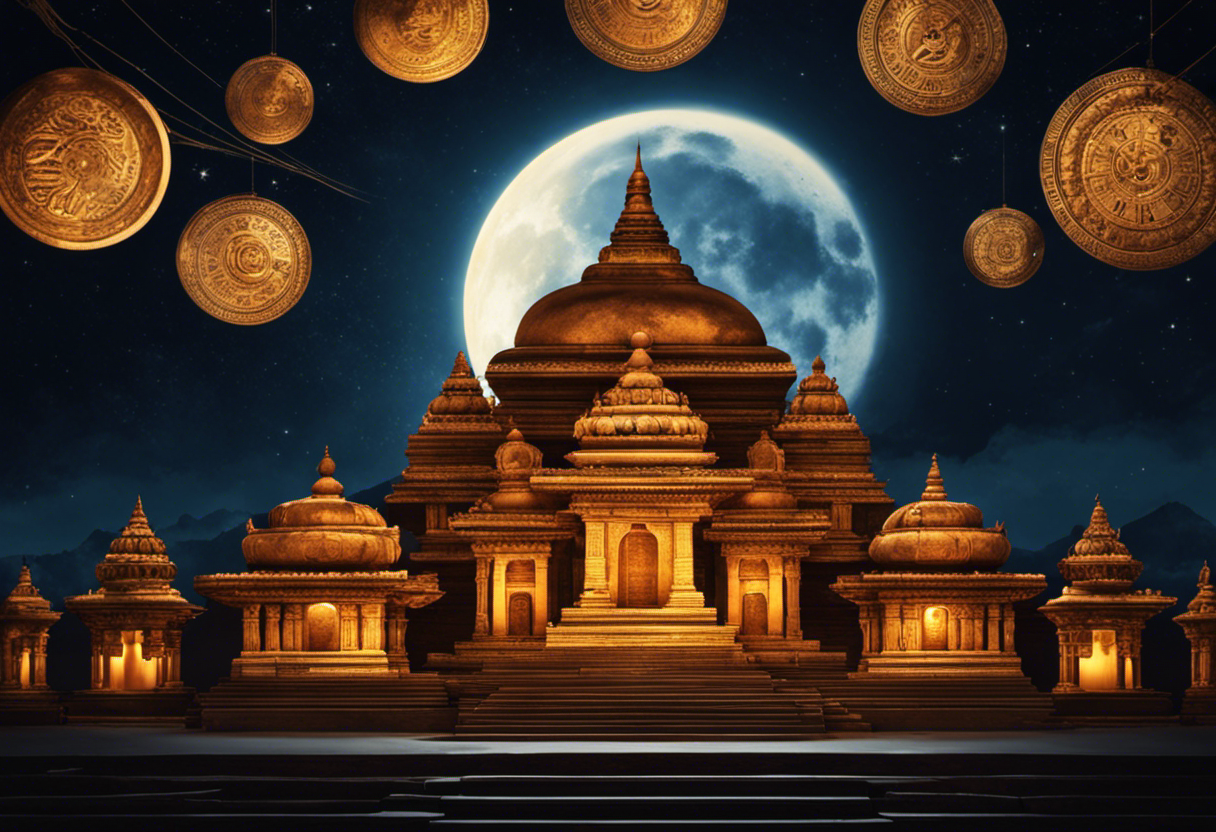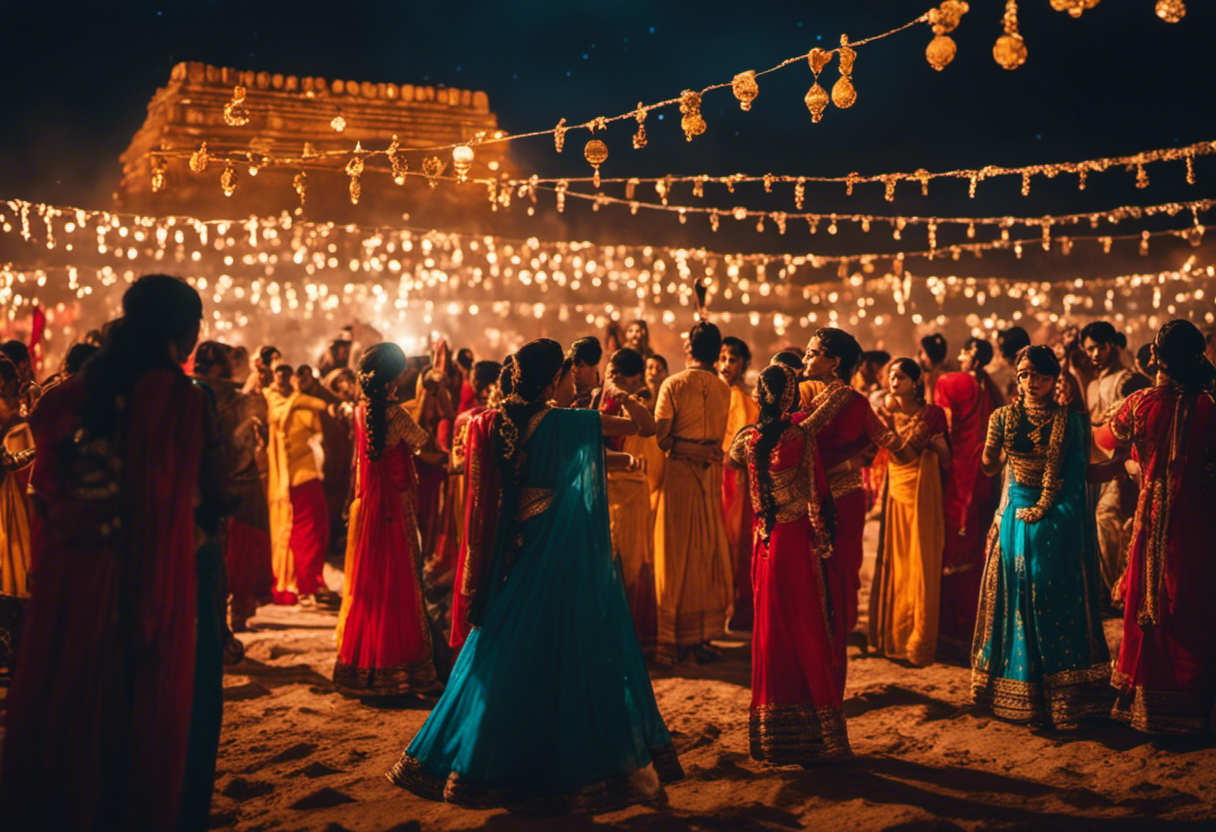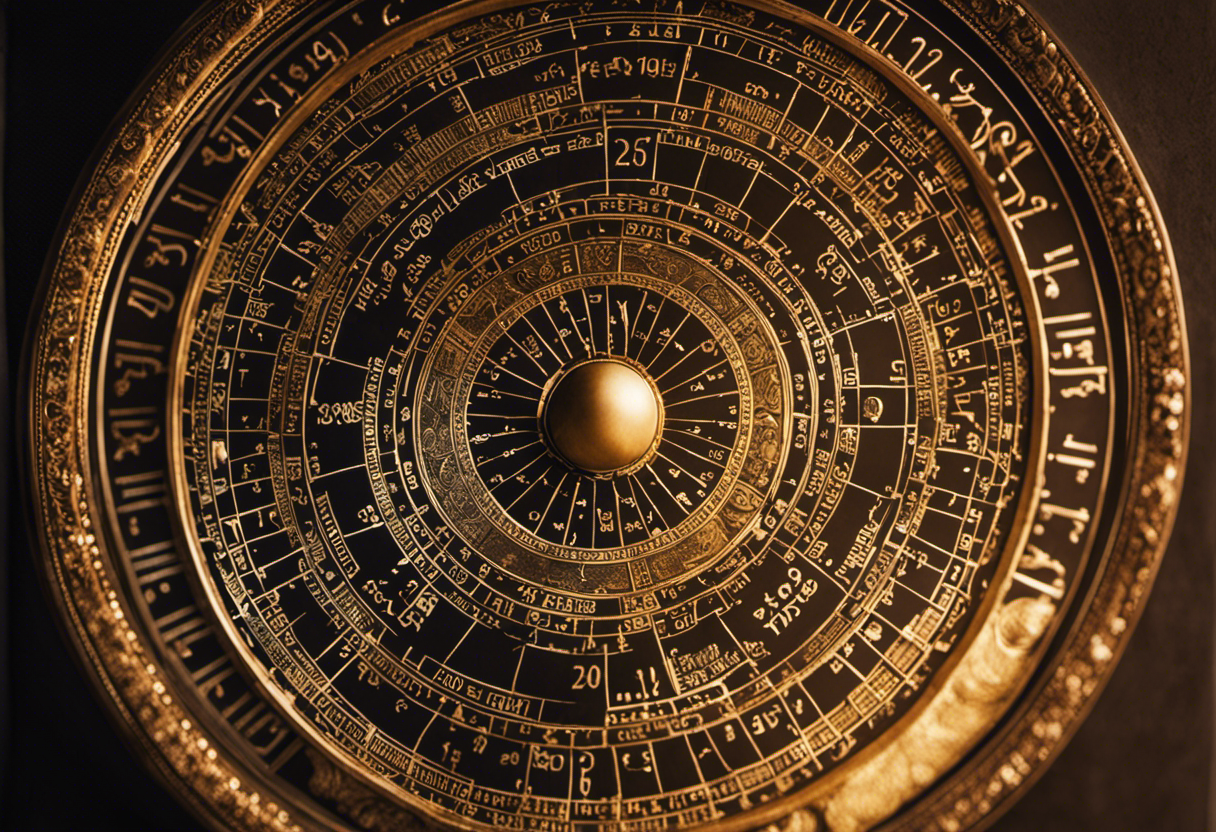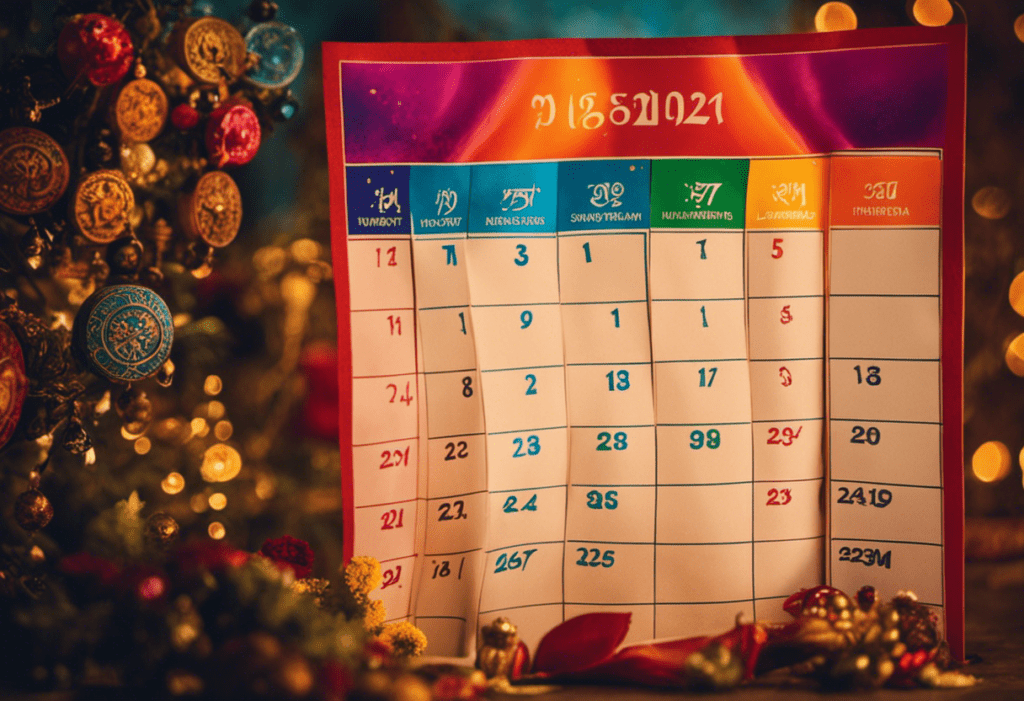Did you know that the Vikram Samvat calendar, followed by Hindus in Nepal and parts of India, relies heavily on the lunar phases?
The lunar cycle plays a crucial role in determining auspicious days for festivals, religious observances, and marriage rituals.
This article explores the significance of lunar phases in Vikram Samvat, highlighting the alignment of time and tradition, the cultural heritage associated with lunar phases, and the precision involved in the calculation of this ancient calendar system.
Key Takeaways
- Vikram Samvat calendar system is based on lunar cycles
- Lunar phases guide the selection of propitious occasions
- Lunar cycles impact the success and longevity of a relationship
- Astrological beliefs and lunar cycles ensure harmony and compatibility in relationships
Impact on Festivals and Religious Observances


One can observe the significant impact of lunar phases on festivals and religious observances in the context of Vikram Samvat. The Vikram Samvat calendar system, followed by Hindus in Nepal and some parts of India, is based on the lunar cycles. As such, the timing and occurrence of festivals and religious observances are intricately linked to the phases of the moon.
The festival impact of lunar phases in Vikram Samvat is evident in the scheduling and celebration of various religious events. For example, the festival of Diwali, also known as Deepavali, is celebrated on the darkest night of the lunar month of Kartik. This is because the new moon night, when the moon is not visible, symbolizes the triumph of light over darkness. Similarly, the festival of Holi is celebrated on the full moon day of the lunar month of Phalgun. The full moon signifies the arrival of spring and is associated with the colorful and joyous celebrations of Holi.
Religious observances also revolve around lunar phases in Vikram Samvat. For instance, the month of Shravan is considered auspicious for the worship of Lord Shiva, with devotees fasting and offering prayers on Mondays. These observances are aligned with the waxing and waning of the moon, symbolizing the cycle of creation and destruction.
Role in Determining Auspicious Days


The lunar phases play a crucial role in determining auspicious days in Vikram Samvat, as they are used to guide the selection of propitious occasions and favorable timings for various events and activities. In Vikram Samvat, which is based on the Hindu calendar system, astrological beliefs hold that the celestial influence of the moon affects human behavior and outcomes. It is believed that the moon’s gravitational pull impacts the earth and its inhabitants, influencing emotions, energy levels, and overall well-being.
As the moon waxes and wanes, its energy is said to fluctuate, creating different vibrations that can either enhance or hinder certain activities. According to astrological beliefs, certain lunar phases are considered more favorable for specific events. For example, the waxing phase, when the moon is increasing in illumination, is believed to be conducive for new beginnings, growth, and initiation of important projects. On the other hand, the waning phase, when the moon is decreasing in illumination, is considered ideal for completion, reflection, and letting go of things that no longer serve a purpose. Additionally, specific lunar phases are believed to be favorable for activities such as weddings, housewarming ceremonies, religious rituals, and business ventures.
Significance for Marriage and Relationship Rituals


The significance of lunar phases in Vikram Samvat extends to marriage and relationship rituals. One aspect of this significance is the belief that certain lunar phases are more compatible for marriage, while others are less favorable.
Additionally, rituals associated with marriage and relationships often take into account the lunar cycles, with specific ceremonies and timings aligned with the moon’s phases.
Lunar Phases and Compatibility
During marriage and relationship rituals, the significance of lunar phases becomes evident in determining compatibility. Astrology plays a crucial role in analyzing the compatibility between individuals based on their astrological charts. The position of the moon at the time of birth is believed to influence a person’s emotional nature and behavior. Therefore, understanding the lunar phases and their impact on individuals becomes essential in assessing compatibility in relationships.
The following are two sub-lists that highlight the significance of lunar phases in astrology compatibility:
-
Moon Sign Compatibility: Different moon signs have distinct characteristics, and compatibility between individuals can be determined by analyzing their moon signs. For example:
-
Aries moon sign individuals are known for their assertiveness and passion, making them compatible with other fire signs like Leo and Sagittarius.
-
Taurus moon sign individuals value stability and security, making them compatible with earth signs like Virgo and Capricorn.
-
Lunar Phases in Relationship Rituals: The choice of auspicious lunar phases is considered vital in marriage and relationship rituals. Couples often consult astrologers to determine the most favorable lunar phase for their wedding or engagement ceremonies. This is believed to enhance compatibility and ensure a harmonious union.
Rituals and Lunar Cycles
For marriage and relationship rituals, understanding the significance of lunar cycles is essential in ensuring the harmony and auspiciousness of the ceremonies.
Ritual practices associated with marriage and relationships often involve the consideration of astrological beliefs and the influence of lunar cycles. According to traditional astrological beliefs, the moon’s position and phases can impact the success and longevity of a marriage or relationship.
Certain lunar phases are considered particularly auspicious for performing marriage rituals, while others are believed to be inauspicious and should be avoided. Astrologers and priests often play a crucial role in guiding individuals and families in selecting the most favorable dates and times for conducting these rituals.
Marriage Timing Considerations
Astrological beliefs and lunar cycles play a significant role in determining the ideal timing for marriage and relationship rituals. The astrological significance of marriage timing is rooted in the belief that planetary influences can impact the success and longevity of a relationship. Here are two sub-lists that highlight the factors considered when determining the auspicious time for marriage:
-
Astrological Considerations:
- The position and alignment of the planets at the time of marriage are analyzed to ensure harmony and compatibility between the couple.
- The astrologer looks at the placement of Venus, the planet of love and romance, to assess the potential for a blissful and fulfilling marriage.
-
Lunar Phases:
- The phase of the moon is also taken into account, with certain phases believed to be more favorable for marriage.
- The waxing moon is considered auspicious for new beginnings, making it an ideal time to start a lifelong journey together.
Alignment of Time and Tradition


The integration of lunar phases into the Vikram Samvat calendar system allows for a harmonious alignment between time and tradition. The celestial influence of the moon has long been recognized in various cultures, and the Vikram Samvat calendar system is no exception. The lunar calendar used in Vikram Samvat follows the cycles of the moon, with each month beginning on the day of the new moon.
This alignment of time and tradition is of great significance in Vikram Samvat. The lunar phases not only dictate the timing of religious and cultural festivals but also influence various aspects of daily life, such as agricultural practices and marriage rituals. The Vikram Samvat calendar ensures that these important events are scheduled in accordance with the lunar phases, ensuring that traditions are followed with precision and accuracy.
Moreover, the alignment of time and tradition in Vikram Samvat allows for a deeper connection to the natural world. By observing and honoring the cycles of the moon, individuals are reminded of the larger cosmic order and their place within it. This integration of lunar phases into the calendar system serves as a reminder of the interconnectedness of time, tradition, and the celestial bodies that govern our lives.
Cultural Heritage Associated With Lunar Phases


Lunar phases in Vikram Samvat calendar system preserve and transmit a rich cultural heritage, connecting generations through the shared understanding and reverence for the moon’s cyclical transformations.
The cultural significance of lunar phases is deeply ingrained in various societies around the world, including those following the Vikram Samvat calendar.
Here are two sub-lists highlighting the cultural heritage associated with lunar phases:
-
Lunar Phase Symbolism:
- The waxing moon symbolizes growth and new beginnings. It is often associated with fertility, creativity, and the start of new projects or ventures.
- The full moon represents completeness, abundance, and illumination. It is traditionally associated with festivals, celebrations, and the peak of spiritual energy.
- The waning moon symbolizes release, letting go, and reflection. It is a time for introspection, self-evaluation, and shedding old habits or beliefs.
-
Lunar Phase Celebrations:
- Many cultures celebrate the new moon as a time for setting intentions and making plans for the future.
- Full moon celebrations are common across various communities, often marked by rituals, dances, and feasts.
- The different lunar phases also play a vital role in determining the timing of religious festivals and observances.
The cultural heritage associated with lunar phases in the Vikram Samvat calendar system enhances the sense of unity, spirituality, and social cohesion within communities. It reminds us of the cyclic nature of life and provides a framework for understanding the passage of time.
Calculation and Precision in the Vikram Samvat Calendar


Ensuring accuracy and reliability, the calculation and precision in the Vikram Samvat calendar system are essential for the proper determination of lunar phases and the corresponding dates of festivals and auspicious occasions.
The Vikram Samvat calendar is an ancient Hindu calendar system that dates back to the 57th century BCE. It follows a lunar-solar calendar, which means that the dates are determined based on the positions of the Sun, Moon, and Earth.
The precision in calculation is crucial in the Vikram Samvat calendar to accurately predict the lunar phases. The calendar takes into account the movement of the Moon around the Earth and the Earth around the Sun, resulting in a complex set of calculations. These calculations involve considering the length of the lunar month, the position of the Sun in the zodiac, and the precession of the equinoxes.
The historical background of the Vikram Samvat calendar highlights the importance of precision in calculation. King Vikramaditya of Ujjain, a legendary emperor, initiated the calendar system to commemorate his victory over the Sakas. The calendar was developed to align with astronomical events and to accurately determine the dates of festivals and auspicious occasions.
Conclusion
In conclusion, the lunar phases play a crucial role in the Vikram Samvat calendar, impacting festivals, religious observances, and auspicious days.
They also hold significance in marriage and relationship rituals, aligning time with tradition.
The cultural heritage associated with lunar phases adds depth and richness to the calendar.
The calculation and precision involved in determining lunar phases highlight the scientific and analytical nature of the Vikram Samvat calendar.




